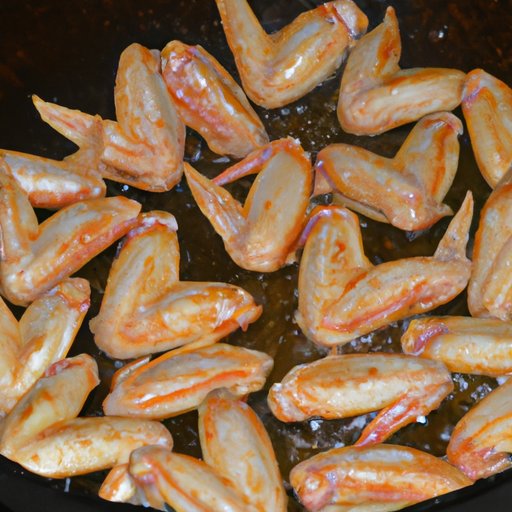I. Introduction
Frying chicken wings can be a daunting task for many, but with the right technique and knowledge, it can be a delicious and rewarding experience. In this article, we will explore the five simple steps to frying perfect chicken wings every time, offer tips and tricks for beginners, provide alternative recipes for those who prefer to go flourless, explain the science behind spicy wings, as well as healthier alternatives for those who want to indulge without the guilt.
II. Five Simple Steps to Frying Perfect Chicken Wings Every Time
Step 1: Preparing the chicken wings. Rinse the wings under cold water and pat dry thoroughly with paper towels.
Step 2: Seasoning the chicken wings. Mix together your desired seasonings in a bowl and rub onto the wings, being sure to coat thoroughly on all sides.
Step 3: Coating the chicken wings. Dip the wings into a mixture of flour and/or cornstarch until well coated.
Step 4: Frying the chicken wings. Heat oil in a deep pot or fryer to around 375°F and carefully lower the wings into the oil. Fry for 10-12 minutes or until golden brown and crispy.
Step 5: Draining and serving the chicken wings. Remove the wings from the oil with a slotted spoon and place on a paper towel to drain excess oil. Serve with your favorite dipping sauce and enjoy!
III. Mastering the Art of Frying Chicken Wings – Tips and Tricks for Beginners
Understanding the different parts of the chicken wing is crucial in ensuring even cooking. When purchasing wings, choose ones that are similar in size and weight for consistency. It’s also important to choose the right oil and temperature for frying – typically peanut, vegetable, or canola oil and a temperature of around 375°F. Using the right equipment, such as a deep pot or fryer, will also help achieve crispy wings. Preheating the oil and not overcrowding the pot are also important factors in ensuring even cooking. For extra crispiness, try double frying the wings!
IV. How to Make Crispy Fried Chicken Wings Without Flour
Some people prefer not to use flour for a variety of reasons. Alternative coatings for chicken wings include using breadcrumbs or panko, as well as cornmeal or potato starch. To achieve crispy wings without flour, try baking the wings in the oven at a high temperature or air-frying them. Both methods will still create a crispy exterior without the use of flour.
V. The Secret to Perfectly Seasoned Fried Chicken Wings – A Step-by-Step Guide
Seasoning is key to achieving delicious and flavorful wings. Whether to season before or after frying is a personal preference, but for maximum flavor, seasoning beforehand and letting the wings marinate for a few hours in the fridge is recommended. Experimenting with different seasonings, such as hot sauce, honey, garlic, or soy sauce, will help create a variety of flavor profiles to suit your taste buds.
VI. From Spicy to Sweet: Creative Recipes for Fried Chicken Wings
Classic spicy buffalo wings are always a fan favorite, but branching out to other flavors can be just as delicious. Sweet and sticky honey glazed wings are perfect for those with a sweet tooth, while Korean-style wings with soy and sesame offer a savory twist. For those who prefer a Caribbean flair, try Jamaican jerk wings with spices such as allspice, thyme, and habanero pepper.
VII. Fry It Up: Healthier Alternatives to Traditional Fried Chicken Wings
Fried chicken wings may not be the healthiest option, but there are alternatives for those who want to indulge without the guilt. Baking wings in the oven with a little bit of oil can still create a crispy exterior, while air-frying offers a healthier option that uses little to no oil. Grilling is also a fantastic option for those who want a smoky flavor without the excess oil.
VIII. Bringing the Heat: The Science Behind the Spiciest Chicken Wings You’ve Ever Tasted
For those who love spicy wings, understanding the Scoville scale and measuring spiciness can help navigate the heat level. The chemical compound responsible for spiciness, capsaicin, binds to receptors in our mouth that cause a burning sensation. Balancing extremely spicy wings can be done by adding sweetness or acidity to the sauce, such as honey or vinegar, to counteract the heat.
IX. Conclusion
With these tips and recipes, frying chicken wings at home can be a fun and delicious experience. Whether you prefer classic buffalo wings or want to experiment with different flavors, there’s a recipe for everyone. Don’t be afraid to try out different techniques and seasonings to make your wings truly your own.
